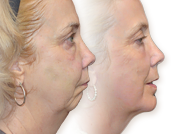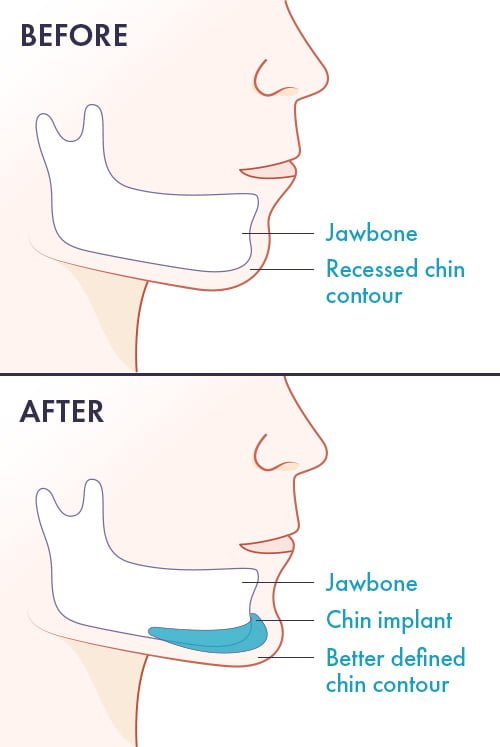What is chin enhancement surgery?
Chin enhancement surgery, also called genioplasty, improves contours of the chin, neck and jawline. Typically, surgery involves placement of an implant around a patient’s existing chin bone to augment the size and shape of the chin and achieve a more naturally attractive balance between facial features. When performed by a qualified, experienced cosmetic surgeon, chin enhancement can provide a permanent solution to improve a weak or recessed chin.
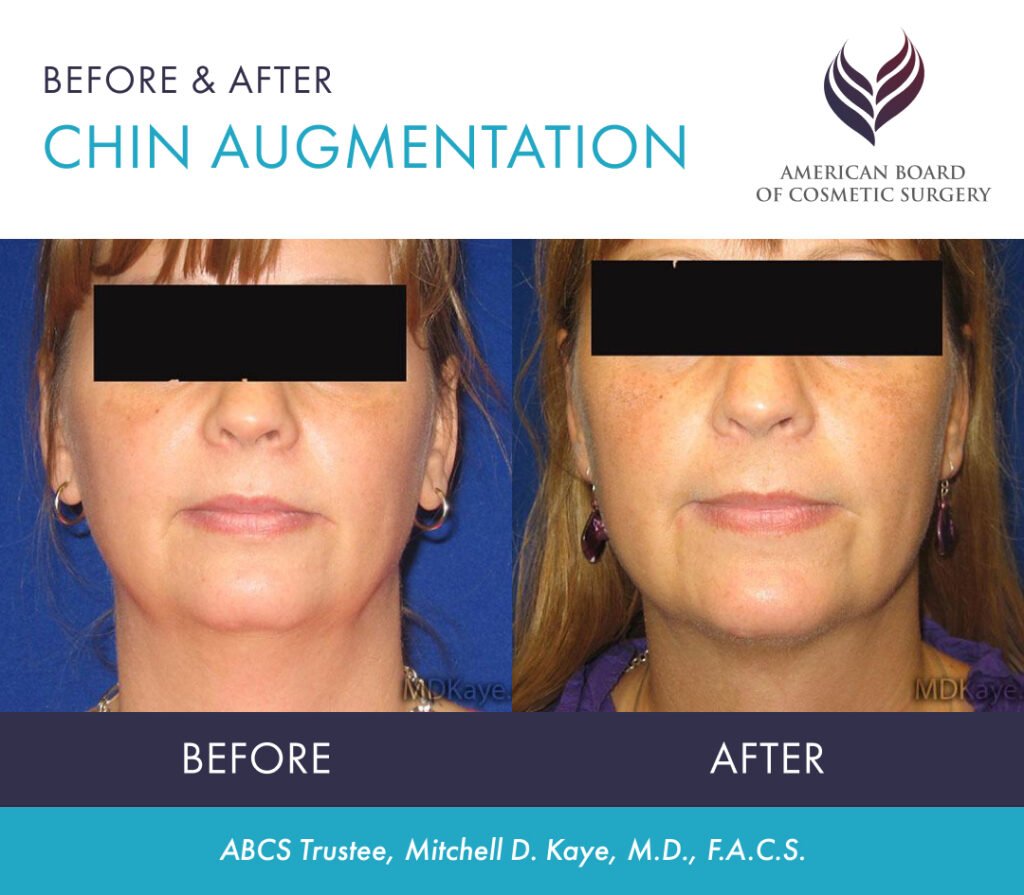
Learn more by choosing from the links below:
- Why consider getting a chin implant?
- Choosing a facial cosmetic surgeon
- How is chin implant surgery performed?
- Recovering after chin implant surgery
- How long will results last?
- What are the risks of chin augmentation?
- More options to enhance the chin and jawline
Why consider getting a chin implant?
If you are bothered by your recessed or “weak” chin, or you feel your facial features lack proportion, chin implant surgery can help you feel more confident in your appearance. Specifically, chin augmentation can:
- Improve facial harmony by bringing chin into better proportion with other features
- Correct a weak or recessed chin
- Improve definition of the neck and jawline
- Help reduce the appearance of a full or “double” chin caused by a small chin bone
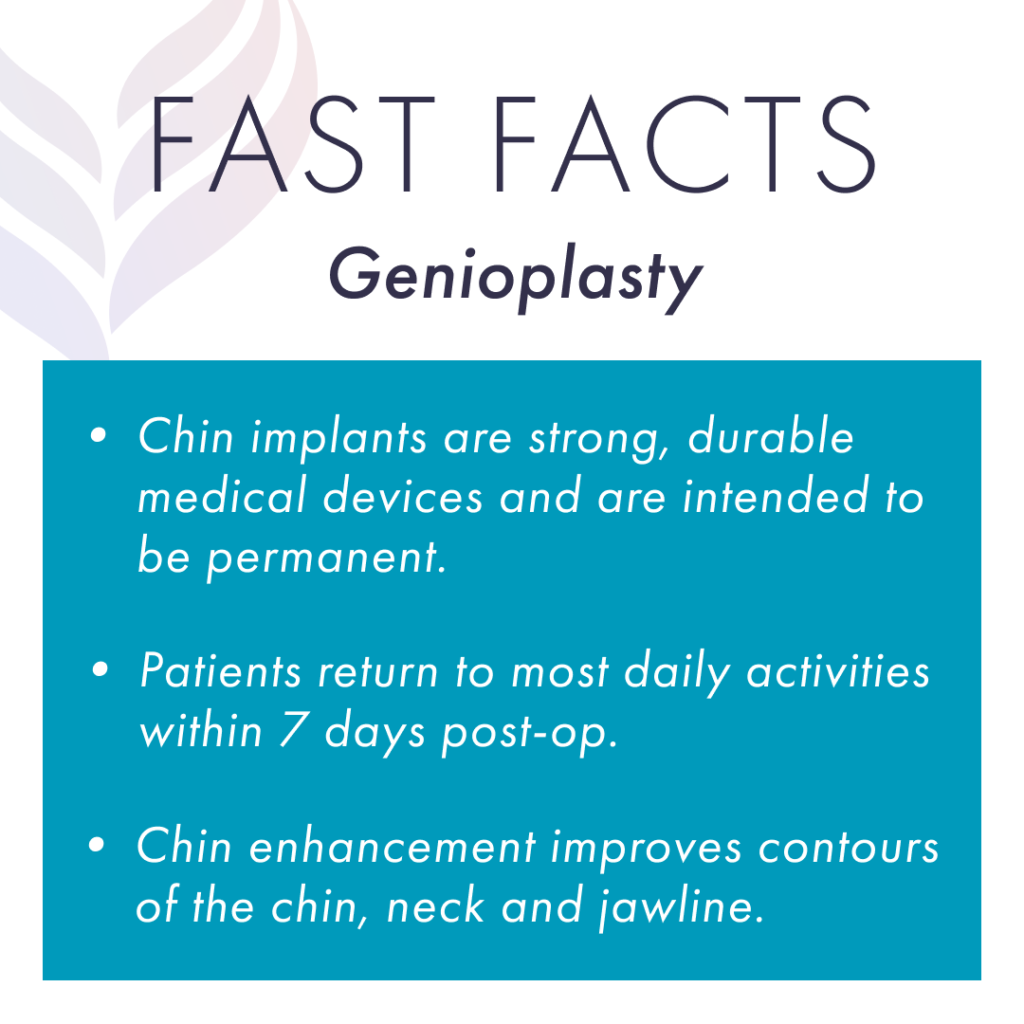
- Key Benefits
- Glossary
- Creates chin definition: Chin implants can add volume and definition to the chin, creating a more prominent and aesthetically pleasing appearance.
- Improves jawline: By creating a more defined chin, chin implants can also improve the appearance of the jawline, creating a more sculpted facial profile.
- Enhances facial harmony: Chin implants can improve the overall balance and harmony of the face by creating a more proportionate chin. This can be particularly beneficial for individuals with a weak or receding chin.
- Genioplasty: The technical term for chin augmentation, which is a surgical procedure that involves reshaping or repositioning the chin to improve its size, position, or symmetry.
- Mentoplasty: Another term for a surgical procedure focused on altering the shape or size of the chin.
- Weak chin: A term used to describe a chin that lacks prominence or projection, often resulting in an imbalanced facial profile.
- General anesthesia: Controlled unconsciousness induced by medications to eliminate pain during surgery.
- Local anesthesia: Administration of medication to numb a specific area of the body, typically used for minor procedures and surgeries.
- Sliding genioplasty: A surgical technique in which a section of the chin bone is cut and repositioned to enhance the projection or shape of the chin.
- Autologous fat transfer: A procedure that involves harvesting fat from one area of the body (often through liposuction) and transferring it to another area to add volume or enhance contours.
- Biocompatible: Referring to a material or substance that is compatible with living tissues and does not typically cause harmful reactions or rejection when implanted.
- Osseous genioplasty: A type of genioplasty that involves modifying the underlying bone structure of the chin to achieve the desired aesthetic or functional outcome.
- Dermal fillers: Injectable substances, such as hyaluronic acid or collagen, used to restore volume, fill in wrinkles or lines, and enhance facial contours.
Choosing a facial cosmetic surgeon
One of the most important decisions you will make when considering chin enhancement is who will perform your surgery. You’ll want to choose a surgeon who has extensive experience in facial cosmetic surgery.
Find ABCS cosmetic surgeons in your area »
When consulting with potential surgeons, ask how many chin augmentation procedures he or she has performed, and be sure to look at before and after photos of other patients. The results you see should look natural to each individual patient. More about choosing a cosmetic surgeon.
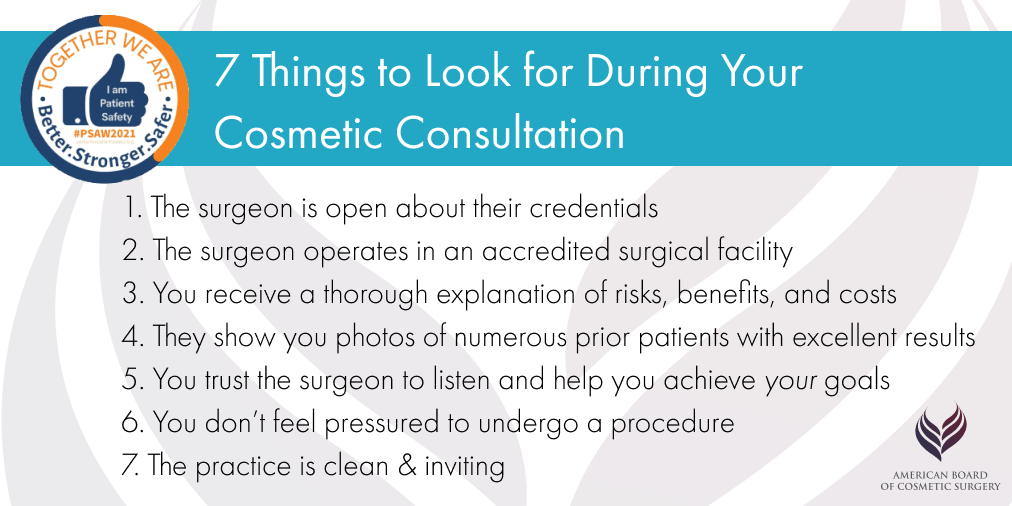
How is chin implant surgery performed?
Chin implant surgery is usually an outpatient procedure, performed using general anesthesia or local anesthesia with sedation. A small incision is made either underneath the chin or inside the mouth. Through this incision, the cosmetic surgeon creates space for the chin implant and fits it around the chin bone.
Chin implant surgery alone typically takes less than 1 hour to perform; however, if you are having additional procedures, operating time will increase accordingly. Following surgery, the incision is closed with sutures and the chin may be bandaged.
What does a chin implant look like?
Chin implants are small, solid devices made from a biocompatible material, usually silicone, which has been molded to fit around a patient’s chin bone. Chin implants vary in size and contour; your cosmetic surgeon will help you choose an implant that will achieve your desired degree of enhancement and provide the most natural looking result.
When inserted, chin implants feel very similar to a natural chin bone, and when performed by a qualified cosmetic surgeon, it is usually impossible to tell that a patient has had chin augmentation.
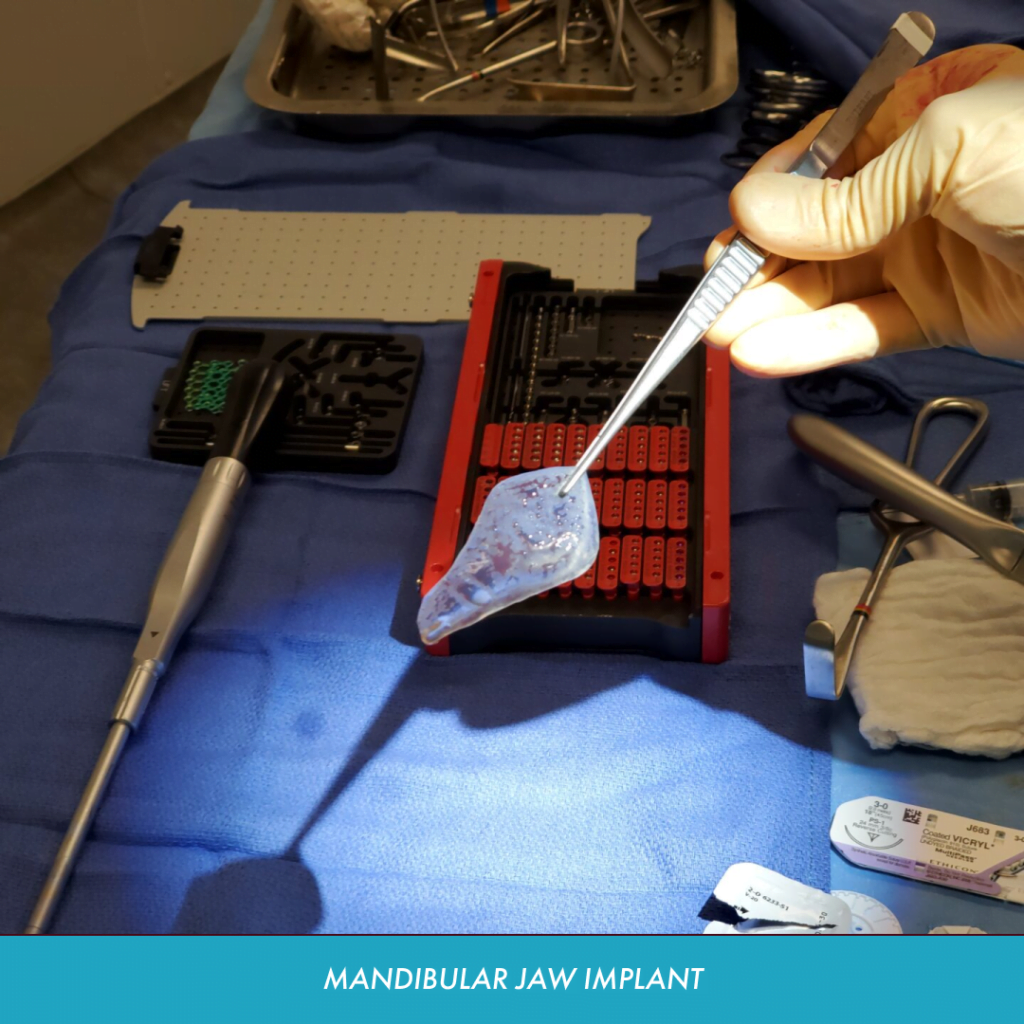
Recovering after chin implant surgery
Most chin augmentation patients experience relatively little downtime and are back to desk work and most other daily activities within 7 days after surgery. Discomfort is typically minimal and easily controlled with pain medication or cold compresses.
You will need to sleep face-up, with your head elevated, for a minimum of 1 to 2 weeks after surgery to help control post-op swelling and protect your healing incisions. Your cosmetic surgeon may also require you to consume a liquid-only diet for a day or two after surgery. Strenuous activity can typically be resumed within 3 to 4 weeks after chin augmentation. It is important to follow your cosmetic surgeon’s specific instructions during recovery to ensure you heal well and your results look great as soon as possible.
Results look close to final within one month after surgery, and are considered final after about 3 months, when residual swelling has subsided.
Results should last throughout the years
Chin implants are very strong, durable medical devices and are intended to be permanent. While the aging process will affect your facial appearance in other ways, your enhanced chin contour will not change. There is a slight risk that trauma to the face could damage a chin implant and require another surgery to replace it.
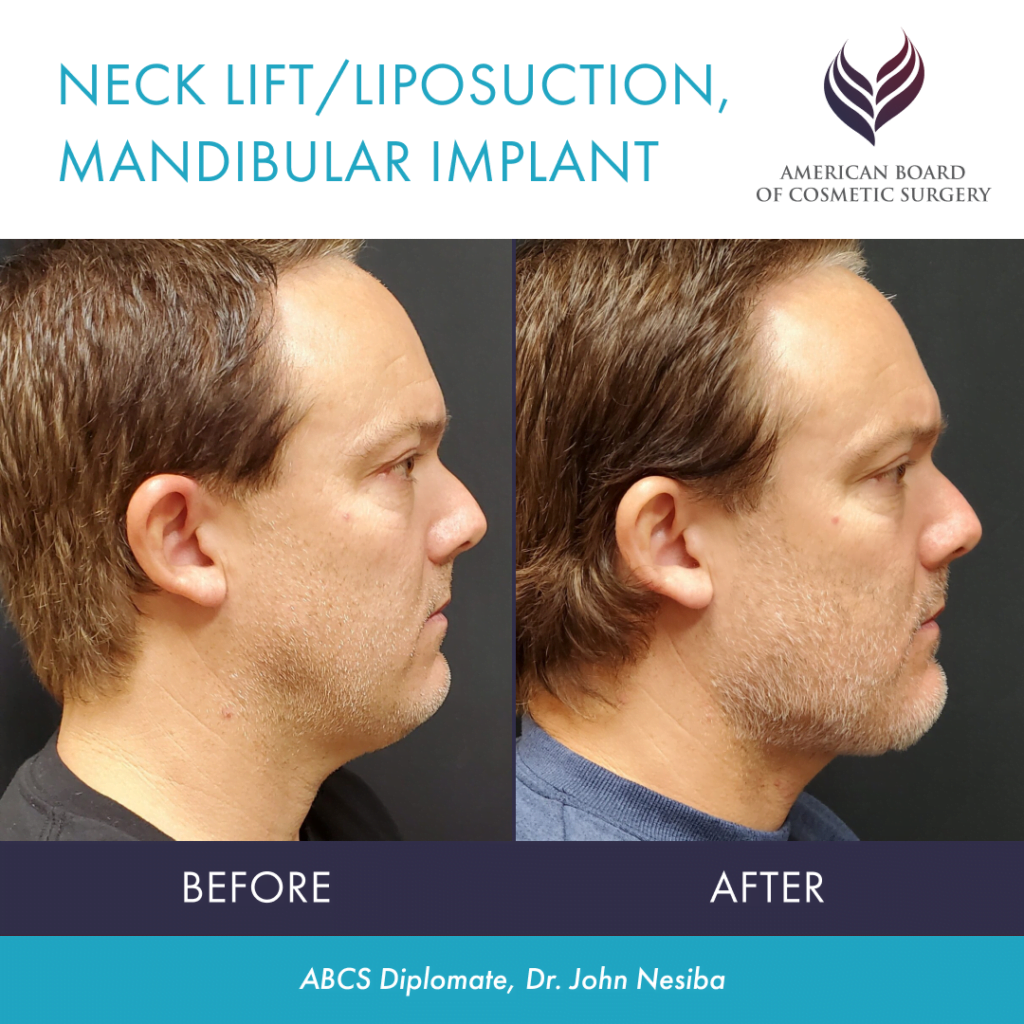
Risks of chin implant surgery
When performed by a qualified, experienced cosmetic surgeon, chin augmentation is associated with very few complications. Possible risks include infection, hematoma (internal bleeding), shift in implant position, poor scarring, and side effects from anesthesia.
You can further minimize risk by choosing a cosmetic surgeon who is certified by the American Board of Cosmetic Surgery. ABCS diplomates have undergone extensive fellowship training in cosmetic surgery, operate exclusively in accredited surgical facilities, and use a board certified MD anesthesiologist for general anesthesia.
Different options to enhance the chin and jawline
While many patients choose to have chin implant surgery alone, just as often chin augmentation will be combined with other procedures for enhanced results.
Rhinoplasty + chin augmentation
Chin implants can dramatically enhance the results of rhinoplasty, and chin augmentation with nose reshaping surgery is one of the most common facial contouring procedure combinations.
Neck liposuction + chin implants
Patients with excess fullness beneath the chin often choose to have neck liposuction at the same time as chin implant surgery. While strengthening the chin will help improve jawline definition on its own, removing excess fat from underneath the chin can further improve the appearance of the lower face and neck.
Want to learn more? Find a qualified cosmetic surgeon near you.
References »
Harris WC, Raggio BS. Facial Chin Augmentation. 2022.
Fanous N, Yoskovitch A. Estimating implant size in chin augmentation: A simplified approach. The Canadian Journal of Plastic Surgery. 2003 Fall;11(3):161-5. doi: 10.1177/229255030301100305.
Newberry CI, Mobley SR. Chin Augmentation Using Silastic Implants. Facial Plastic Surgery. 2019 Apr;35(2):149-157. doi: 10.1055/s-0039-1683867.
Beer K, Kaufman-Janette J, Bank D, Biesman B, Dayan S, Kim W, Chawla S, Schumacher A. Safe and Effective Chin Augmentation With the Hyaluronic Acid Injectable Filler, VYC-20L. Dermatologic Surgery. 2021 Jan 1;47(1):80-85. doi: 10.1097/DSS.0000000000002795.
Moradi A, Shirazi A, David R. Nonsurgical Chin and Jawline Augmentation Using Calcium Hydroxylapatite and Hyaluronic Acid Fillers. Facial Plastic Surgery. 2019 Apr;35(2):140-148. doi: 10.1055/s-0039-1683854.
Sykes JM, Suárez GA. Chin Advancement, Augmentation, and Reduction as Adjuncts to Rhinoplasty. Clinics in Plastic Surgery. 2016 Jan;43(1):295-306. doi: 10.1016/j.cps.2015.09.021.
